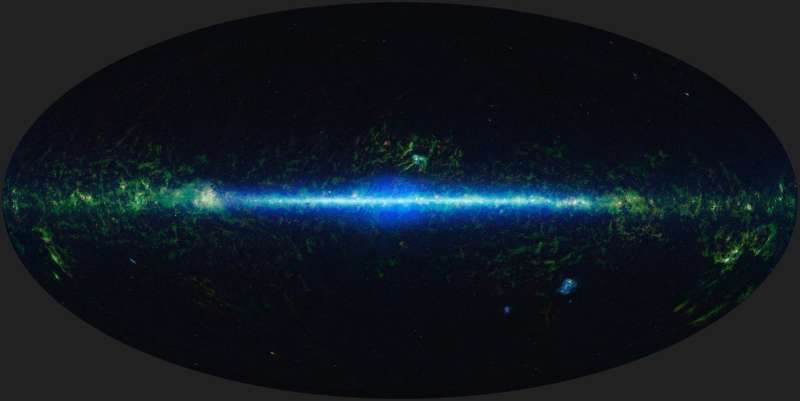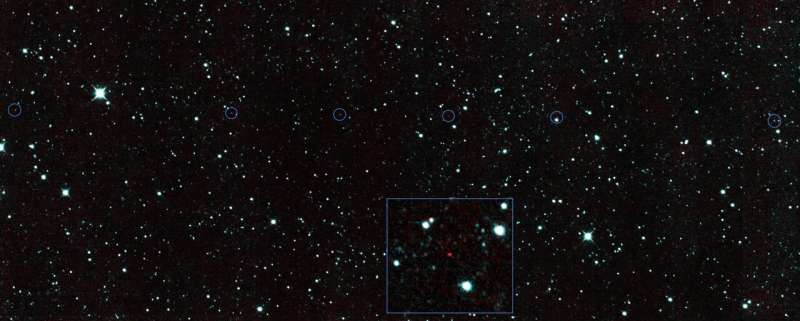This article has been reviewed according to Science X's editorial process and policies. Editors have highlighted the following attributes while ensuring the content's credibility:
fact-checked
trusted source
proofread
NASA's NEOWISE infrared heritage will live on

NASA's near-Earth-object-hunting mission NEOWISE is nearing its conclusion. But its work will carry on with NASA's next-generation infrared mission: NEO Surveyor.
After more than 14 successful years in space, NASA's NEOWISE (Near-Earth Object Wide-field Infrared Survey Explorer) mission will end on July 31. But while the mission draws to a close, another is taking shape, harnessing experience gained from NEOWISE: NASA's NEO Surveyor (Near Earth Object Surveyor), the first purpose-built infrared space telescope dedicated to hunting hazardous near-Earth objects. Set for launch in late 2027, it's a major step forward in the agency's planetary defense strategy.
"After developing new techniques to find and characterize near-Earth objects hidden in vast quantities of its infrared survey data, NEOWISE has become key in helping us develop and operate NASA's next-generation infrared space telescope. It is a precursor mission," said Amy Mainzer, principal investigator of NEOWISE and NEO Surveyor at the University of California, Los Angeles.
"NEO Surveyor will seek out the most difficult-to-find asteroids and comets that could cause significant damage to Earth if we don't find them first."
WISE beginnings
NEOWISE's end of mission is tied to the sun. About every 11 years, our star experiences a cycle of increased activity that peaks during a period called solar maximum. Explosive events, such as solar flares and coronal mass ejections, become more frequent and heat our planet's atmosphere, causing it to expand. Atmospheric gases, in turn, increase drag on satellites orbiting Earth, slowing them down.
With the sun currently ramping up to predicted maximum levels of activity, and with no propulsion system for NEOWISE to keep itself in orbit, the spacecraft will soon drop too low to be usable.
The infrared telescope is going out of commission having exceeded scientific objectives for not one, but two missions, beginning as WISE (Wide-field Infrared Survey Explorer).
Managed by NASA's Jet Propulsion Laboratory in Southern California, WISE launched in December 2009 with a six-month mission to scan the entire infrared sky. By July 2010, WISE had achieved this with far greater sensitivity than previous surveys, and NASA extended the mission until 2011.
During this phase, WISE studied distant galaxies, outgassing comets, exploding white dwarf stars, and brown dwarfs. It identified tens of millions of actively feeding supermassive black holes. It also generated data on circumstellar disks—clouds of gas, dust, and rubble spinning around stars—that citizen scientists continue to mine through the Disk Detective project.
In addition, it excelled at finding main belt asteroids, as well as near-Earth objects, and discovered the first known Earth Trojan asteroid. What's more, the mission provided a census of dark, faint near-Earth objects that are difficult for ground-based telescopes to detect, revealing that these objects constitute a sizeable fraction of the near-Earth object population.

Infrared heritage
Invisible to the naked eye, infrared wavelengths are emitted by warm objects. To keep the heat generated by WISE itself from interfering with its infrared observations, the spacecraft relied on cryogenic coolant. By the time the coolant had run out, WISE had mapped the sky twice, and NASA put the spacecraft into hibernation in February 2011.
Soon after, Mainzer and her team proposed a new mission for the spacecraft: to search for, track, and characterize near-Earth objects that generate a strong infrared signal from their heating by the sun.
"Without coolant, we had to find a way to cool the spacecraft down enough to measure infrared signals from asteroids," said Joseph Masiero, NEOWISE deputy principal investigator and a scientist at IPAC, a research organization at Caltech in Pasadena, California.
"By commanding the telescope to stare into deep space for several months, we determined it would radiate only enough heat to reach lower temperatures that would still allow us to acquire high-quality data."
NASA reactivated the mission in 2013 under the Near-Earth Object Observations Program, a precursor to the agency's current planetary defense program, with the new name NEOWISE.
By repeatedly observing the sky from low Earth orbit, NEOWISE has made 1.45 million infrared measurements of over 44,000 solar system objects to date. That includes more than 3,000 NEOs, 215 of which the space telescope discovered. Twenty-five of those are comets, among them the famed comet NEOWISE that was visible in the night sky in the summer of 2020.
"The spacecraft has surpassed all expectations and provided vast amounts of data that the science community will use for decades to come," said Joseph Hunt, NEOWISE project manager at JPL. "Scientists and engineers who worked on WISE and through NEOWISE also have built a knowledge base that will help inform future infrared survey missions."
The space telescope will continue its survey until July 31. Then, on Aug. 8, mission controllers at JPL will send a command that puts NEOWISE into hibernation for the last time. Since its launch, NEOWISE's orbit has been dropping closer to Earth. NEOWISE is expected to burn up in our planet's atmosphere sometime between late 2024 and early 2025.
Provided by NASA




















